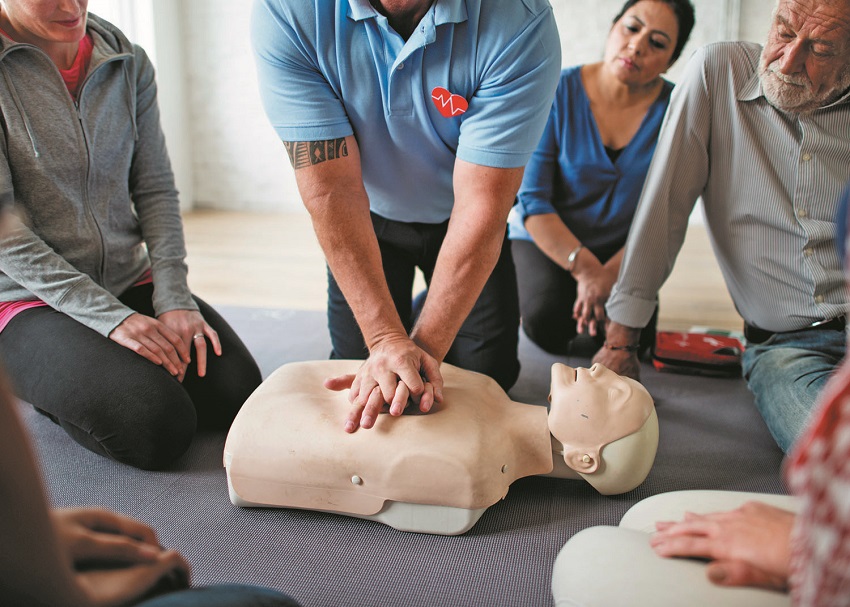The Push You Need To Learn CPR

Image: © Rawpixel Ltd/Thinkstock
Each year, an estimated 600,000 Americans suffer a cardiac arrest, during which the heart suddenly and unexpectedly stops beating. If someone nearby immediately begins cardiopulmonary resuscitation (CPR), the chest compressions can keep blood flowing to the person's brain and other vital organs — and more than double the odds of survival.
"About 70% of cardiac arrests happen at home. If this happened to your spouse or loved one, wouldn't it be awful if you didn't know what to do?" says Dr. Charles Pozner, associate professor of emergency medicine at Harvard-affiliated Brigham and Women's Hospital. But only 18% of adults in the United States have been trained in CPR within the past two years, according to a recent nationwide survey of 9,022 people, published in the May 24, 2017, Journal of the American Heart Association.
There was some encouraging news, however: 65% of the survey respondents said they'd been trained at some point previously. People who are required to know CPR for their jobs need to be recertified every one to two years. For everyone else, that frequency probably isn't realistic. But all adults should take an in-person CPR class at least once, says Dr. Pozner. In many states, learning CPR is mandatory to graduate from high school, which may explain why younger people are more likely to have CPR training than older people are.
CPR training: A vital step
If you've never taken a CPR class (or it's been many years since you have), you can find one through the American Heart Association (AHA) or the American Red Cross. You'll practice hands-only CPR—pushing hard and fast on the center of the chest — on a rubber torso. The action can keep blood circulating until the person's heart can be shocked back into a normal rhythm with a defibrillator. Emergency personnel will bring and use this device. But airports, malls, casinos, sports arenas, and many office buildings also have automatic external defibrillators (AEDs). So if you witness a cardiac arrest in a public place, ask a bystander to find one. AEDs use voice prompts, lights, and text messages to guide users through the needed steps. Most CPR classes also include defibrillator training; some also teach CPR with breaths, which is recommended for victims of drowning or drug overdose.
You can learn CPR basics from a one-minute AHA video at www.heart.org/HandsOnlyCPR. But there's no substitute for hands-on practice to give you a sense of the correct pressure and rate of compressions, says Dr. Pozner. Another place to practice is at one of the training kiosks that are currently located at six airports in the United States: Dallas/Fort Worth, Chicago O'Hare, Indianapolis, Las Vegas' McCarran, Hartsfield-Jackson Atlanta, and Baltimore-Washington Thurgood Marshall.
Don't hesitate to help
Less than one-third of people who experience sudden cardiac arrest receive CPR from a bystander. While increased CPR training rates will likely help, another possible barrier is the fear of doing incorrect or unneeded CPR, according to Dr. Pozner. "We used to train people to spend time checking for breathing and a pulse. But if you can't easily find a pulse and the person isn't breathing normally, assume that he or she is in cardiac arrest. A quick response is more important," he says.
If you're not sure if someone needs CPR, err on the side of caution. "It's better do CPR on someone who doesn't need it rather than not do it on someone who does," Dr. Pozner says. Yes, properly done CPR can break a person's ribs, but that's very unlikely to be fatal.
CPR coaching from your phone or virtual assistant
About half of the 911 operators in the United States are trained to provide verbal cues for CPR, according to the American Heart Association (AHA). If you reach a trained operator, put your phone on speaker to hear the instructions; he or she will count out loud to help you administer compression at the correct rate (about 100 beats per minute).
You can also get CPR coaching and other science-based information from the AHA from an Amazon Echo, a so-called virtual assistant device that you control with your voice. More than eight million people in the United States have these devices, which respond to the name Alexa. To use it, you need to enable the skill in the Alexa app or by saying, "Alexa, enable American Heart Association." Then, in an emergency, you would say: "Alexa, ask American Heart ... how do I perform CPR?"
Story Credit: http://www.health.harvard.edu/heart-attack/the-push-you-need-to-learn-cpr


